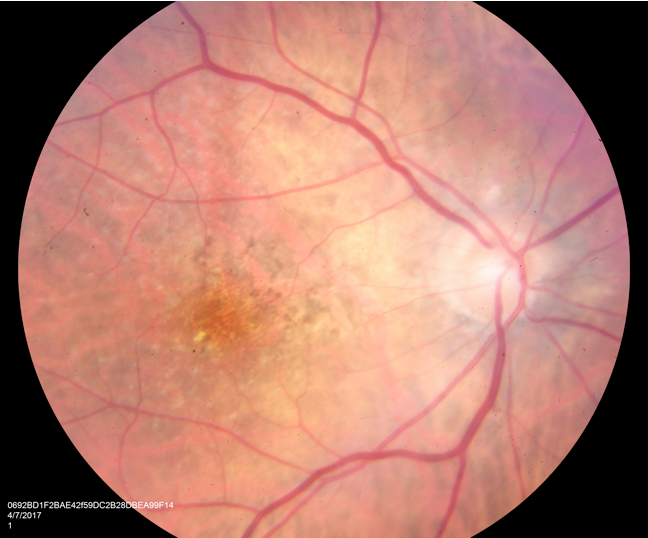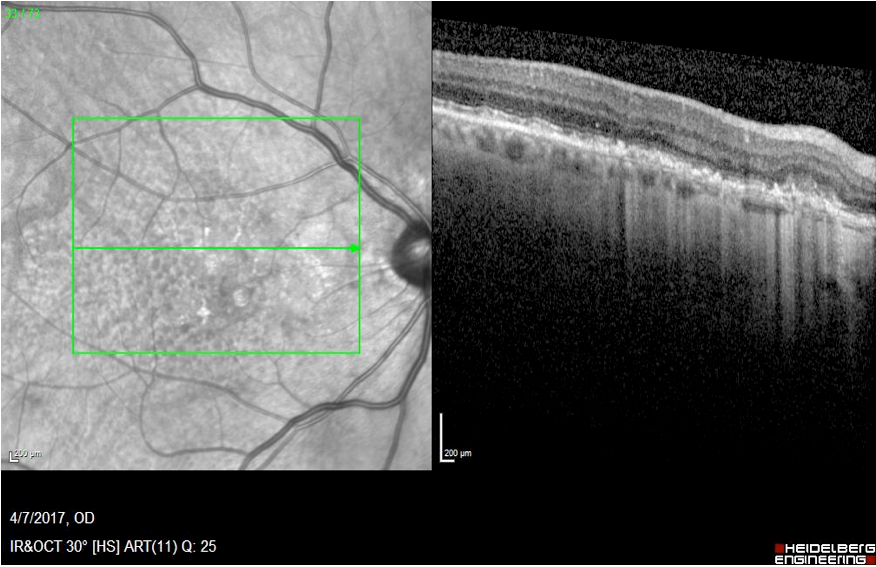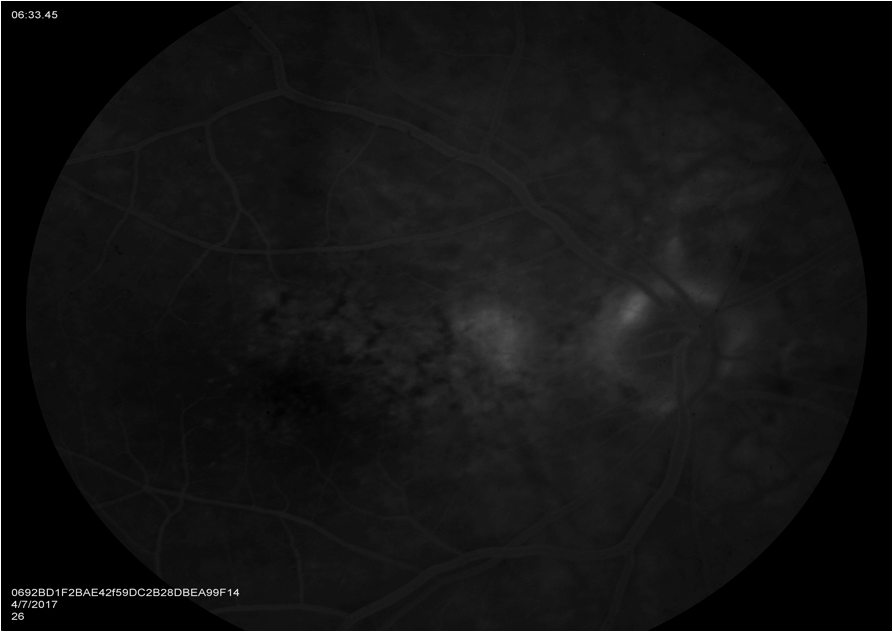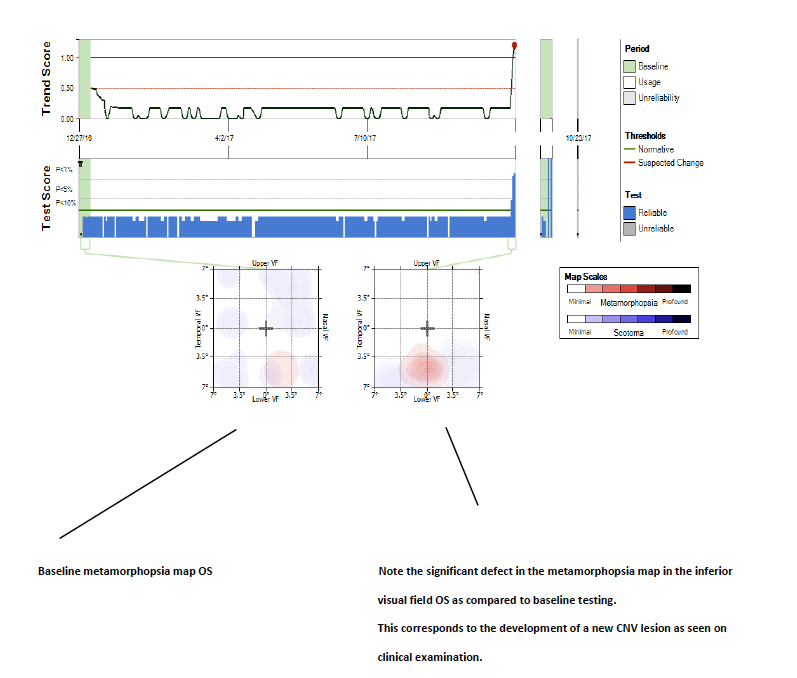Article
AMD home-monitoring device: case studies
Author(s):
Figure 1. Fundus Photo OD showing macular drusen and RPE changes with no evidence of sub-retinal hemorrhage.

Figure 2. OCT OD showing a very small nasal to fovea pigment epithelial detachment (PED) with trace hyper-reflective subretinal material (SHRM) but no frank subretinal or intraretinal fluid.

Figure 3. Late phase fluorescein angiography (FA) OD showing late leakage consistent with a CNV lesion just temporal to optic disc. Due to the high index of suspicion with a positive alert from the device, meticulous additional testing with FA was ordered and proved to be critical to diagnose the early CNV lesion.

Figure 4. ForeseeHome Report


Editor’s Note: Welcome to “Eye Catching: Let's Chat,” a blog series featuring contributions from members of the ophthalmic community. These blogs are an opportunity for ophthalmic bloggers to engage with readers with about a topic that is top of mind, whether it is practice management, experiences with patients, the industry, medicine in general, or healthcare reform. The views expressed in these blogs are those of their respective contributors and do not represent the views of Ophthalmology Times or UBM Medica. This is part three of a three-part Clinical Innovations series discussing the results from case studies using an at-home monitoring system for patients with AMD. Joshua Mali, MD, is a vitreoretinal surgeon at The Eye Associates, a private multispecialty ophthalmology practice in Sarasota, FL.
As of 2014, more than 15 million Americans are estimated to have age-related macular degeneration (AMD).i The percentage of patients who will progress from early or intermediate dry AMD to advanced stages of the disease over five years ranges from 0.5% to 45%, depending on a number of risk factors including drusen size and retinal pigment epithelium (RPE) changes.ii On average, however, studies have shown that the median progression rate of dry AMD ranges from 1.49 mm2 per year to 2.29 mm2 per year. iii
However, the ability to predict which patients will have a rapid rate of progression and which will be unlikely to progress significantly over time is highly challenging, if not impossible. In addition to the AREDS 5-year risk scale,2 other risk factors, such as family history and lifestyle, may make progression more likely although there is no definitive progression model.
This uncertainty understandably causes great anxiety for patients and doctors alike as we work diligently to detect the progression from dry AMD to wet AMD as soon as possible. With the home-use monitoring device (ForeseeHome device, Notal Vision), we finally have a viable option for consistent, accurate monitoring and early detection.
Impact to treatment plan
The device allows me to catch wet AMD early in the conversion process. Prior to utilizing it, I did not have many options for monitoring my patients with AMD. My patients were generally put on the AREDS2 vitamin formulation recommended in the Age-Related Eye Disease Study 2 (AREDS2) and instructed not to smoke, have a good diet, exercise regularly, and utilize sunglasses.
In addition, they were also given an Amsler grid to self-monitor for any vision changes. However, predicting which patients will truly progress to wet AMD, and when, is a challenge. While the Amsler grid has helped many patients since its development, its ability to detect change is inconsistent.iv
Additionally, by the time the patient notices a significant difference in his or her own visual acuity, severe and potentially irreversible damage might have already transpired. With the home-use device, patients and doctors do not need to rely solely on utilizing a lined piece of paper to prompt recognition of visual acuity changes.
Now, we have a more objective, reliable tool that can detect minute changes and directly alert the eye-care provider when there are significant changes in vision and retinal anatomy. Once an alert is issued, we can schedule an immediate follow-up appointment and perform an examination to confirm choroidal neovascularization (CNV).
Case studies
Fortunately, of the more than 100 patients I currently have on the device, I have had only a few patients receive non-CNV alerts and only two patients who have had a CNV alert.
My first case involves a 75-year-old female with a history of exudative AMD in her left eye – treated with intravitreal aflibercept (Eylea, Regeneron) and intermediate dry AMD in her right eye. Her visual acuity was 20/30 OD at baseline. When the device alert was triggered, the patient was asymptomatic yet I still instructed her to come to the office as soon as possible for an evaluation.
Upon examination of the patient (Figure 1), she was still 20/30 OD and the OCT (Figure 2) had borderline findings, however, a small CNV membrane was confirmed on fluorescein angiography (Figure 3). Of note, the location of the CNV was just temporal to the optic disc and therefore not involving the central macula at this point.
Consequently, the patient was asymptomatic and the conversion to exudative AMD was confirmed solely with clinical examination and additional testing with OCT and fluorescein angiography. The aflibercept treatment was initiated and the patient is currently 20/25 OD.
The home-use device was critical in bringing this patient into my office for evaluation and allowed for prompt management. As this patient was already receiving treatment for wet AMD in her fellow eye, she knew the stakes were high and was happy for the early detection and saving her sight.
My other CNV alert was from a 78-year-old female with a history of exudative AMD in her right eye–also being treated with intravitreal aflibercept–and intermediate dry AMD in her left eye. Her left eye baseline visual acuity was 20/40. Of note, this patient typically spends six months in Sarasota, FL and six months in Cincinnati, OH. When the home-use device alert occurred in her left eye, she was completely asymptomatic and was at that time still in Cincinnati.
After analyzing her report (Figure 4), I immediately arranged for her to be evaluated in Cincinnati in which her vision was still 20/40 OS but on dilated fundus exam there was the presence of subretinal fluid and subretinal hemorrhage noted in the macula OS. The patient received her first anti-VEGF (vascular endothelial growth factor) injection OS in Cincinnati and she then returned to Sarasota where I have continued her current treatment regimen. She currently has maintained her 20/40 vision OS due to prompt response to the FSH alert and early anti-VEGF treatment initiation.
As with most diseases in medicine, earlier detection often results in a less-aggressive disease overall, less treatment needed in the long run, and a much better outcome where we can preserve and perhaps even improve vision. This device has great potential for patients who have dry AMD with vision that is 20/60 or better in the testing eye. Basically, any patient who is prescribed AREDS2 vitamins and meets the device’s eligibility criteria should be prescribed this device.
Patients do not need to be tech savvy as the device is easy to use. It also has a good training program designed to help anyone learn how to use it, whether it is learning how to use a computer mouse or connecting the device to Wi-Fi.
Additionally, there are very helpful educational aids in place to help patients understand the device and emphasize the importance of consistent/regular testing. The bottom line is, if the patient is in danger of developing wet AMD, he or she needs to be on the device to provide the highest level of patient care.
Joshua Mali, MD, is a board-certified ophthalmologist and award-winning vitreoretinal surgeon at The Eye Associates, a private multispecialty ophthalmology practice in Sarasota, Florida. He can be reached at 941-923-2020.
Disclosures:
Dr. Mali’s relevant financial disclosures include the following: Notal Vision Inc. (consultant, speaker), Regeneron (consultant, speaker, stock shareholder, research funding).
References:
i Wong WL, Su X1, Li X, et al. Global prevalence of age-related macular degeneration and disease burden projection for 2020 and 2040: a systematic review and meta-analysis. Lancet Glob Health. 2014;2(2):e106-116.
iiDavis MD, Gangnon RE, Lee LY, et al. Age-Related Eye Disease Study Group. The Age-Related Eye Disease Study severity scale for age-related macular degeneration: AREDS Report No. 17. Arch Ophthalmol. 2005;123:1484-1498.
iiiLim PC, Layton CJ. Prognostic implications of imaging in atrophic macular degeneration and its use in clinical practice and clinical trial design. Clin Exp Ophthalmol. 2016;44:410-421.
ivCrossland M, Rubin G. The Amsler chart: absence of evidence is not evidence of absence. Br J Ophthalmol. 2007;91:391-393.
Newsletter
Don’t miss out—get Ophthalmology Times updates on the latest clinical advancements and expert interviews, straight to your inbox.





